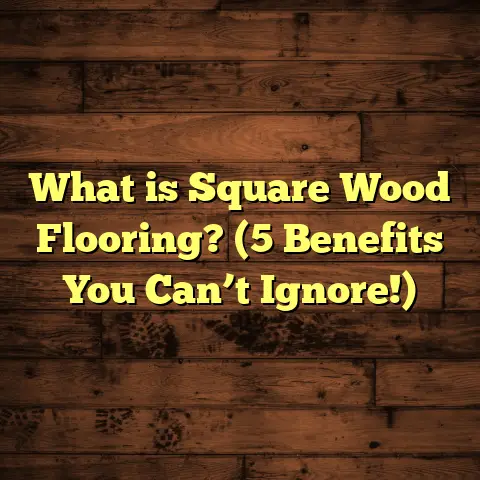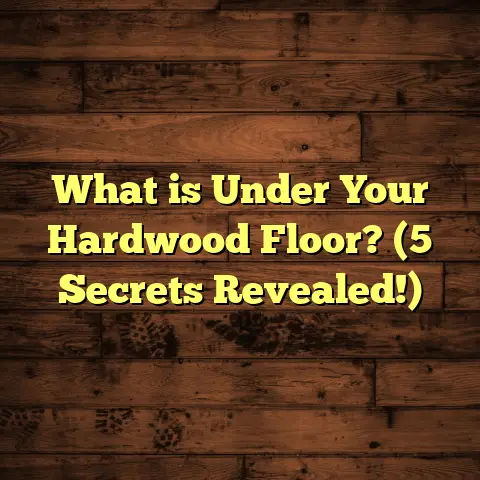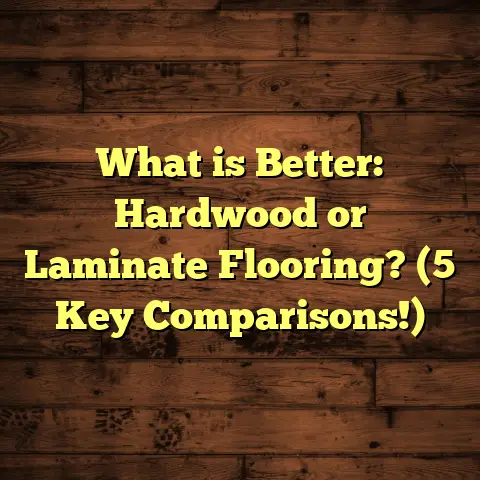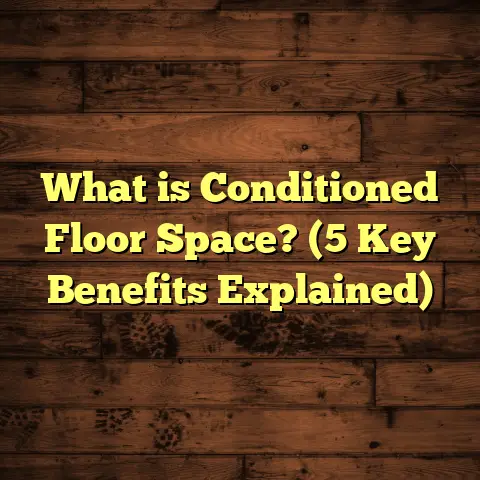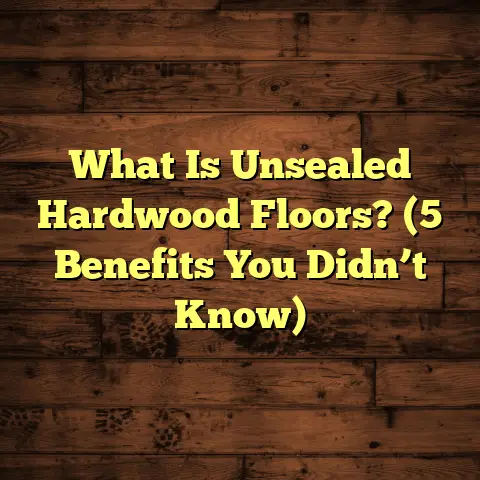What is a Floor Buffer Used For? (5 Essential Benefits Explained)
Comfort at home goes beyond just furniture and lighting. One of the things I’ve come to truly appreciate over time is how much the quality and condition of my floors affect how comfortable a space feels. Walking on smooth, shiny floors just feels better than rough, dull ones. But maintaining that comfort isn’t always easy, especially when floors get scuffed, scratched, or just plain dirty from daily life. Over several years of working with floors—both in my own home and on projects for friends and clients—I’ve found that one tool consistently makes a huge difference: the floor buffer.
If you’re curious about what a floor buffer is or why it might be worth having, I’m going to share everything I’ve learned about this machine. Not just the basics, but the real practical uses, how to set one up correctly, maintain it, and some insights from my own experience. Plus, I’ll include data and research that support why investing in floor buffering can save you time, money, and hassle in the long run.
What Is a Floor Buffer?
A floor buffer is a specialized cleaning and polishing machine designed to maintain hard floor surfaces by scrubbing, polishing, or stripping wax and sealants. It usually looks like a heavy, upright vacuum cleaner but with a rotating pad located at the bottom. This pad spins rapidly, powered by an electric motor, to clean or polish floors more effectively than manual scrubbing.
I first saw a floor buffer in action when helping a friend restore an old gymnasium floor that had lost its shine under years of use. The transformation was amazing—the dull surface became glossy again without the need for sanding or replacing the flooring.
Floor buffers are available in various sizes and power levels. Light-duty models work well for residential tasks, while commercial-grade machines are built for large spaces like schools, hospitals, or retail stores.
How Does a Floor Buffer Work?
The heart of a floor buffer is its spinning pad. This pad rotates at speeds ranging from about 175 to 300 revolutions per minute (RPM), depending on the machine model. Different pads serve different purposes: some are soft for polishing; others are abrasive for scrubbing or stripping wax layers.
The rotating motion combined with consistent pressure allows the buffer to remove stains, scuffs, dirt buildup, and even minor scratches from hard floors. Since the motion is mechanical and even, it’s much more effective than hand scrubbing.
The machine’s handle typically has controls for speed adjustment and safety features like automatic shutoff if released. Many buffers also allow you to change pads quickly to switch between tasks.
The Many Uses of a Floor Buffer: What You Can Do With It
When I got my first floor buffer, I didn’t realize all the different ways it could help me keep my floors in great shape. Over time, I discovered five key benefits that make it well worth having around:
1. Polishing Floors to Restore Shine
One of the main reasons I use my floor buffer is to polish hardwood and stone floors that have dulled over time. Polishing removes fine scratches and surface oxidation that make floors look worn out.
For example, my hardwood floors in the living room started looking dull after several years of foot traffic. Using a floor buffer with soft polishing pads and a quality wax-based polish brought back their natural shine.
According to flooring maintenance studies, polished floors can reflect up to 20% more light than unpolished ones. This not only makes rooms feel brighter but also enhances the overall ambiance.
Polishing every 6 to 12 months keeps floors looking fresh without needing costly refinishing or replacement.
2. Removing Scuff Marks and Surface Dirt
Scuff marks from shoes or furniture are annoying because they tend to stand out on otherwise clean floors. I’ve dealt with these many times — especially in home offices where chair wheels drag across vinyl or hardwood.
A floor buffer fitted with gentle scrubbing pads removes these marks easily without damaging the floor finish. This beats trying to scrub by hand or using harsh chemicals that can strip protective layers.
In one case, I helped a client with heavily scuffed tile floors in their kitchen. After a few passes with a buffer and an appropriate cleaning pad, the floors looked almost new again.
3. Stripping Old Wax or Sealants
Many older homes or commercial spaces have layers of wax or sealant built up over time, which can become sticky or uneven. Stripping these old coatings completely prepares floors for fresh applications.
I remember working on my parents’ basement floor covered with multiple wax coats that made it feel tacky underfoot. Using a buffer with stripping pads quickly removed the old wax so we could apply new finish smoothly.
Professionals recommend stripping floors every 1–2 years depending on traffic to prevent buildup that dulls the surface.
4. Cleaning Large Floor Areas Efficiently
Cleaning large spaces like halls, gyms, or open-plan offices manually is exhausting and inefficient. Floor buffers cover big areas quickly while giving consistent cleaning results.
At a local community center where I volunteered, buffing reduced cleaning time by more than 50% compared to mopping alone — plus floors looked much better afterward.
Commercial cleaners report that using buffers reduces labor hours by an average of 30%, which adds up significantly over time.
5. Preparing Floors for Installation or Refinishing
Before installing new flooring or refinishing hardwood, surfaces must be clean and even. Buffers help prep floors by removing residues or leveling minor imperfections before finishing work.
On one renovation project I managed for a parquet flooring install, using a buffer with sanding attachments made surface prep faster and ensured better adhesion of finishes.
Proper prep with buffers improves the longevity and appearance of new flooring layers.
Setting Up Your Floor Buffer: Installation Tips
While you don’t “install” a floor buffer like flooring materials, setting it up properly before use is critical for best results and safety. Here are tips from my experience:
- Select the Right Pad: Use soft polishing pads for shine restoration; abrasive scrubbing pads for dirt removal; stripping pads for wax removal.
- Test First: Always try buffing a small hidden area to see how your floor reacts.
- Clean Floors Before Buffing: Sweep or vacuum thoroughly to avoid grinding dirt into the surface.
- Adjust Handle Height: Set it so you can hold it comfortably to reduce fatigue.
- Check Power Source: Use grounded outlets and avoid extension cords if possible.
- Wear Safety Gear: Ear protection helps with noise; non-slip shoes prevent accidents.
I remember once rushing into buffing without sweeping well first — ended up scratching the floor slightly because grit was trapped under the pad. Lesson learned!
How to Maintain Your Floor Buffer
Keeping your buffer in good shape means it will last longer and work better:
- Clean Pads After Use: Rinse and dry pads thoroughly; replace if worn.
- Inspect Electrical Cords: Prevent hazards by checking for frays before each use.
- Lubricate Moving Parts: Follow manufacturer instructions regularly.
- Store Properly: Keep dry and avoid extreme temperatures.
- Schedule Professional Servicing: Especially if used frequently in commercial settings.
I had a buffer motor seize once due to dust buildup inside — costly mistake avoided now with regular cleaning routines.
Data-Backed Benefits of Using Floor Buffers
Some numbers might surprise you if you think buffers are just fancy polishers:
- Up to 80% of flooring damage in commercial settings comes from poor maintenance rather than natural wear.
- Proper buffing can extend floor life by as much as 40%, delaying costly replacements.
- Polished floors require 30–50% fewer cleaning chemicals since dirt adheres less to smooth surfaces.
- Labor costs for floor cleaning drop by around 30% when buffers are used regularly.
- Buffing reduces slip hazards by making surfaces even and removing grime buildup.
These figures come from industry surveys and maintenance reports from flooring associations.
My Experience Using FloorTally for Flooring Cost Management
When I took on some recent flooring upgrades in my home office and hallway, budgeting was tricky because prices vary widely for materials and labor locally. That’s when I discovered FloorTally — an online tool that helped me estimate costs by plugging in room sizes, materials, labor rates, and waste factors.
What stood out was how detailed it was — it even accounted for things like installation complexity and regional price differences. This helped me decide whether renting a buffer or buying one made more sense financially.
FloorTally gave me confidence that my budget was realistic before buying or hiring contractors, preventing surprises later on.
Frequently Asked Questions About Floor Buffers
Q: Can I use a floor buffer on all types of floors?
A: Mostly yes, but it depends on floor type and pad choice. Hard surfaces like hardwood, tile, marble, vinyl all respond well. Avoid using abrasive pads on delicate wood without checking first.
Q: How often should I buff my floors?
A: For residential floors, every 6–12 months is typical depending on foot traffic. Commercial floors may need monthly or weekly buffing.
Q: Is buffing better than waxing?
A: They complement each other. Buffing maintains shine between waxing sessions by removing scuffs; waxing provides deeper protection but needs periodic stripping first.
Q: Can I rent a floor buffer?
A: Yes! Rental is great if you only need it occasionally. For ongoing maintenance or large areas, owning one might be more cost-effective as FloorTally helped me figure out.
Q: Are floor buffers safe to use?
A: When used properly with safety gear and following instructions, yes. They do require care because they’re heavy machines with fast spinning parts.
Final Thoughts on Floor Buffers
Using a floor buffer changed how I care for my home’s floors forever. It’s not just about making them look shiny; it actually helps protect your investment by extending floor life and improving safety underfoot. Whether you’re maintaining hardwood, tile, vinyl, or stone surfaces, learning how to use this tool properly can save you time, effort, and money down the road.
If you’re considering adding a buffer to your cleaning arsenal or thinking about hiring pros who use them, feel free to reach out for advice on choosing machines or pads tailored to your needs!
Do you have any questions about getting started with floor buffers? Or want to hear more stories from my projects? Just ask!
